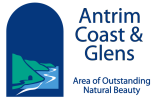Geology
Fair Head, Rathlin and KintyreThe geology of the Antrim Coast & Glens is dominated by tertiary basalts which formed part of a massive lava flow some 55-60 million years ago overlying other older sedimentary rocks including sandstone, shale and limestone. In the north-eastern part of the area the basalt has been eroded away to reveal silvery schists more than 300 million years old.
This has created a landscape of many contrasts with red sandstone, white limestone, black basalt and grey clays often reflected in place names such as, Red Bay, Black Cave and White Bay. The area is also characterised by a series of deep glens running eastwards to the North Channel, known as the ‘Nine Glens of Antrim’. These are the product of glaciation and were formed during the last Ice Age.
Travelling north the coastal part of the AONB is characterised by a series of striking headlands including Ballygally Head, Garron Point, Torr and Fair Head and by Rathlin Island. Inland the Antrim Plateau, an exposed and desolate landscape, has its own wild beauty. Slemish Mountain is a distinctive landmark and Trostan, the highest point on the plateau, reaches a height of 550m.
The unique geology of the area has also created some varied and dramatic coastal scenery. Following the last Ice Age sea levels fell to leave a series of raised beaches along the coast such as those at South Bay near Carnlough. Sea stacks such as the White Lady at Garron Point and often caves like those at Red Bay were also left high and dry as sea levels adjusted after glaciation. Other features of interest along the coast include the conglomerate caves at Cushendun and fossils are common within the lias clay and white limestone at Drumnagreagh near Glenarm. There are dramatic cliffs along much of the coastline but this is particularly the case on Rathlin Island.
Flora & Fauna
The Antrim Plateau is a harsh and open landscape. Partly covered by blanket bog its mosaic of heath and pools can provide cover for ground nesting birds such as the red grouse and hen harrier. It is also home to many rare plants such as the insect-eating butterwort.
The rocky coastline supports a rich array of marine life. Whales, dolphins, seals and occasionally otters visit this coast and Rathlin Island attracts over 250,000 breeding seabirds each year including razorbill, kittiwake and puffin. It is also noted for its many rare sponges. Elsewhere fulmars breed along the cliffs whilst cormorants can often be seen diving and fishing from the rocks. Buzzards are common in the more intimate landscape of the glens which includes some fine native ash and hazel woodland such as the National Nature Reserves at Straidkilly and Glenariff. The small spate rivers, home to the dipper, still receive runs of both sea trout and salmon.
Yellow ‘whin’ bushes and red fuchsia break up the hawthorn hedges and primroses, bluebells and orchids provide colour in spring. As summer progresses these give way to harebell, bird’s-foot-trefoil and the rare wood vetch. Other less common plants include the pyramidal bugle on Rathlin Island and the rare wood crane’s-bill at Feystown.
Many other species make this AONB their home including for example the common blue and large heath butterflies, damselflies, bats, badger, fox and hare.
Designated Natural Heritage Sites
The Garron Plateau has been designated as a RAMSAR site. This recognises this site as a wetland of international importance. The blanket bog habitat is particularly important for a range of breeding birds including golden plover, red grouse, merlin and hen harrier and for its specialist bogland plant communities.
Rathlin Island is the only Special Protection Area within the AONB. These are breeding bird sites recognised by the UK government as having international importance and are protected at European level. Rathlin is important for its breeding seabird community.
There are three Special Areas of Conservation within the AONB. These areas are considered as some of the most seriously threatened habitats in Europe and are protected at European level. Rathlin Island, Garron Plateau and Breen Wood are all designated sites with Breen recognised as one of the best examples of old sessile oak woodland in Northern Ireland.
In addition to these designations, five sites have been designated as National Nature Reserves. Slieveanorra NNR is important in helping to explain the different stages of peat bog formation. These sites are considered to be of national importance.
Finally EHS has designated over 20 Areas of Special Scientific Interest within the AONB such as Scawt Hill near Ballygally which has geological interest and is also a breeding site for the peregrine falcon.
As elsewhere in Northern Ireland there are also non statutory sites managed or owned by voluntary organisations. There are additionally Sites of Local Nature Conservation Interest (SLNCI) however these are mainly in private ownership.
For further information on access to natural heritage sites contact staff at either EHS or the Causeway Coast and Glens Heritage Trust.

